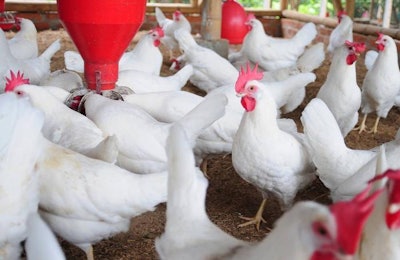
High costs and low prices continue to afflict the poultry sector in Pakistan, but now major disease concerns are adding to its woes.
Avian influenza concerns
Avian flu has hit broilers in the region of Faisalabad during the current period of monsoon rains, according to a source at the Punjab Livestock Department, and Pakistan Today reports that the prices that farmers receive for their birds have consequently declined sharply. Consumers are reluctant to buy chickens, particularly as local media have reported that some producers are attempting to sell sick birds.
In local markets, the retail price of live chickens has gone down from PKR190 (US$1.82) to PKR140 (US$1.34) per kilo within recent days.
The World Organisation for Animal Health (OIE) has not received any official reports of recent avian influenza outbreaks in Pakistan, although Newcastle disease is thought to be present in both domestic and wild birds.
Newcastle disease threat
Newcastle disease (also known as ranikhet in South Asia) is a continuous threat to the poultry sector in Pakistan, according to Dr. Sumeera Akhtar in a recent article in The Nation.
Ever present in wild and domestic birds, the disease is endemic and poses a constant risk to domestic poultry, where it causes “significant losses” to farmers every year.
Vaccines are available and used extensively to protect poultry but they are not always effective, according to Akhtar. Multiple strains of the virus circulating in avian species, and the reduced ability of the chickens’ immune systems to respond to the vaccine due to other circulating diseases are likely reasons for the reduction in vaccination efficacy.
Huge losses accrued by the poultry industry
Pakistan’s poultry industry has lost PKR43 billion (US$411 million) in just one year, The Nation reported earlier this week.
The figure was announced earlier this week in Lahore by Pakistan Poultry Association North Zone Chairman, Rai Mansab Ali Kharal. He added a warning that the situation is likely to deteriorate further as the sale price is not rising in line with increasing costs, and that up to half of farms may have to close. This would reduce the supply of relatively cheap protein to the lower classes and render thousands of people jobless, he said.
Kharal appealed to the government to provide a subsidy of PKR20 (US$0.19) per kilo subsidy to every poultry farmer, and to banks to provide new interest-free loans and allow a penalty-free, 12-month postponement on the repayment of existing loans.
He estimated the burden on the poultry industry of the government’s recent changes to sales tax and import duty on soybean meal, grandparent chicks and hatching eggs at PKR10 billion (US$95.6 million).
“This industry is in crisis despite playing an important role in economic growth and providing cheaper protein to the people,” he said.
In July, it was reported that taxes had been proposed on poultry breeding stock imported into Pakistan.
Just two months ago, Pakistan Today reported that Finance Minister Senator Ishaq Dar assured a delegation of Pakistan Poultry Association (PPA) that genuine problems facing the poultry sector would be addressed so that the sector could achieve growth within the value-added chain and reach international standards.

















